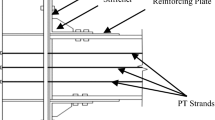Abstract
This paper describes the investigation on the inelastic behavior of steel heavy clip-angle connections subjected to static loading. The work depends on the results of a large experimental investigation into the cyclic behavior of full-scale connections involving thick clip-angle components. The results of these experimental tests are described first, and then a methodology to simulate the response of clip-angle connections numerically using nonlinear finite element (FE) models is mainly treated in this study. Extensive studies utilizing numerous 3D models are discussed, including the introduction of the pretension force into the bolts and the effects of small changes in geometry on the deformation capacity of the angles. Generally, FE test results show a good agreement with experimental test results. These outcomes indicate that it is possible to model such connections successfully if care is exercised in the modeling phase. Moreover, these FE models provide useful instrumentation which is difficult to obtain during an experiment. They have widely been used to understand the parametric effect of connection components and establish a comprehensive study of their inelastic behavior including slip deformation and prying action.
Similar content being viewed by others
References
ABAQUS (2006). Standard User’s Manual. Hibbit, Karlsson and Sorenson, Inc.
AISC (1993). Manual of Steel construction, Load and Resistance Factor Design (LRFD). 1 st edition, American Institute of Steel Construction Chicago, I.L., USA.
Citipitioglu, A. M., Haj-Ali, R. M., and White, D. W. (2002). “Refined 3D finite element modeling of partially-restrained connections including slip.” Journal of Constructional Steel Research, 58, pp. 995–1013.
Hu, J. W. (2008). Seismic performance evaluations and analyses for composite moment frames with smart SMA PR-CFT connections. Ph.D. Dissertation, Georgia Institute of Technology, Atlanta, G.A., USA.
Hu, J. W., Kang, Y. G., Choi, D. H., and Park, T. (2010). “Seismic design, performance, and behavior of compositemoment frames with steel beam-to-concrete filled tube column connections.” International Journal of Steel Structures, 10(2), pp. 177–191.
Kim, Y. J., Shin, K. J., and Kim, W. J. (2008). “Effect of stiffener details on behavior of CFT column-to-beam connections.” International Journal of Steel Structures, 8(2), pp. 119–133.
Kishi, N., Ahmed, A., and Yabuki, N. (2001). “Nonlinear finite element analysis of top-and-seat angle with double web angle connections.” Journal of Structural Engineering and Mechanics, 12(21), pp. 201–214.
Kulak, G. L., Fisher, J. W., and Struik, J. H. A. (1987). Guide to design criteria for bolted and riveted joint. 2 nd edition, Johns Wiley & Sons, New-York, N.Y., USA.
Kumuro, M., Kishi, N., and Chen, W. F. (2005). “Elastoplastic FE analysis on moment-rotation relations of top-and-seat angle connections.” Connection in Steel Structures 5, AISC/ECCS, Amsterdam, June 3–4.
Leon, R. T., Hu, J. W., and Schrauben, C. (2005). “Rotational capacity and demand in top-and-seat angle connections subjected to seismic loading.” Connections in Steel Structure 5, AISC/ECCS, Amsterdam, June 3–4.
Liu, J. and Astaneh-Asl, A. (2000). “Cyclic tests of simple connection including the effect of slabs.” Journal of Structural Engineering, ASCE, 126(1), pp. 32–39.
Schrauben, C. S. (1999). Behavior of full-scale bolted beam-to-column T-stub and clip angle connections under cyclic loading. Master’s Thesis, Georgia Institute of Technology, Atlanta, G.A., USA.
Swanson, J. A. (1999). Characterization of the strength, stiffness, and ductility behavior of T-stun connection. Ph.D. Dissertation, Georgia Institute of Technology, Atlanta, G.A., USA.
Swanson, J. A. and Cao, X. (2000). “Strength determination of heavy clip-angle connection components.” Connections in Steel Structure 4, AISC, pp. 234–243.
Swanson, J. A. and Leon, R. T. (2000). “Bolted steel connections: Tests on T-stub subcomponents.” Journal of Structural Engineering, ASCE, 126(1), pp. 50–56.
Swanson, J. A., Kokan, D. K., and Leon, R. T. (2002). “Advanced finite element modeling of bolted T-stub connection components.” Journal of Constructional Steel Research, 58, pp. 1015–1031.
Author information
Authors and Affiliations
Corresponding author
Additional information
Note.-Discussion open until August 1, 2011. This manuscript for this paper was submitted for review and possible publication on May 25, 2010; approved on August 27, 2010.
Rights and permissions
About this article
Cite this article
Hu, JW., Leon, R.T. & Choi, E. Investigation on the inelastic behavior of full-scale heavy clip-angle connections. Int J Steel Struct 11, 1–11 (2011). https://doi.org/10.1007/S13296-011-1001-y
Published:
Issue Date:
DOI: https://doi.org/10.1007/S13296-011-1001-y




